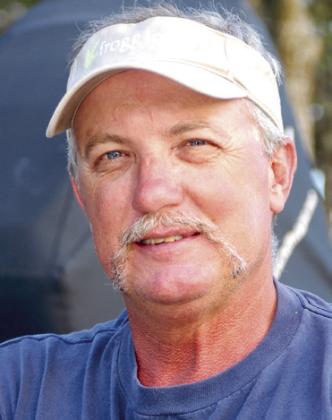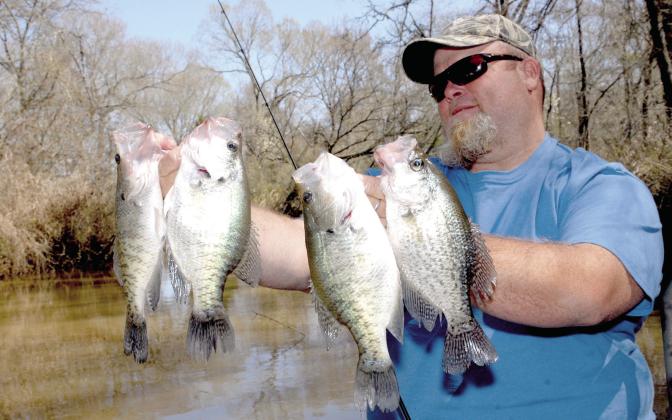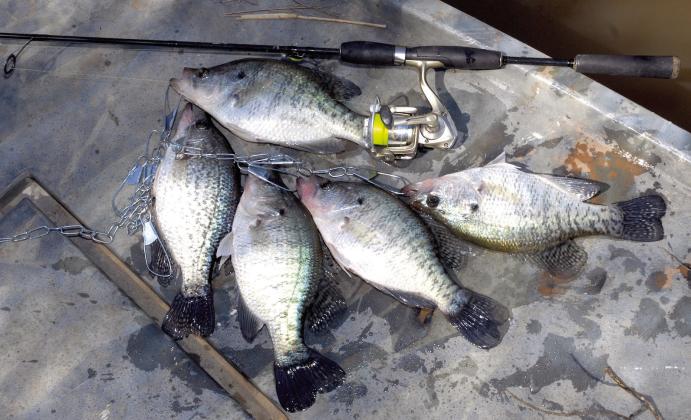Texas guides offer up tips for catching late spring/summer slabs
The Great Outdoors
Most panfish junkies will agree: Crappie are only where you find them.
A school fish by nature, the tasty panfish might be here one day and over there the next. Find one crappie and others are likely to be nearby.
There are two species of crappie — black and white crappie — and both are common to Texas waters. Black crappie do best in the more acid reservoirs found in the eastern part of the state. White crappie can be found in lakes statewide, but tend to thrive in more turbid reservoirs with some color to the water.
It is not uncommon for both species to grow beyond two pounds. Bigger ones are more abundant on some lakes than others.
Texas’ state records for both species have stood for a while. Toledo Bend produced the state’s biggest black crappie, a 4.00 pounder caught in December 2002, according to records maintained by Texas Parks and Wildlife’s Angler Recognition Program. The state record white crappie — a 4.56 pounder from Navarro Mills in Central Texas — dates way back to February 1968.
There are a passel of good crappie lakes in Texas, but some tend to produce better fishing — and bigger bites — than others do. And the advent of forward-facing sonar technology has made it easier to exploit these fish than ever before.
One student of technology recently told me “only a fool would go crappie fishing without it.” I’m not sure about that, but I do know forward-facing sonar is way different than traditional sonar.
It works using a special transducer that mounts to the trolling motor shaft or an independent pole. Anglers can slip quietly along as the transducer scans the water column all around the boat. High resolution imagery relays to the electronics screen in real time.
One of the main benefits is it boosts the chances of seeing inherently spooky fish before they know you are around. Another is it helps anglers make precise bait presentations to fish and, more importantly, see how they react to baits.
Lake Fork crappie fishing guide Gary Paris is a FFS fan for a couple reasons.
“First off it helps eliminate a lot of unproductive water very quickly,” he said. “If Live-Scope isn’t showing you any fish, there is no sense in fishing there. You just keep looking until you find them.”
Proper bait presentation at the right depth is essential. Paris says FFS helps him tune in quickly and make adjustments on the fly.
“If you know what depth the fish are, it helps keep the bait right in their faces 100 percent of the time because you can see it,” he said. “If the fish move, you just stay with them. You can’t do that with traditional sonar.”
Late Spring: All About Location
Late spring is a time of transition for crappie. With the spawn winding down, the fish begin a gradual to deeper water, where they will spend the summer, fall and winter.
Paris looks offshore to find post-spawn schools in water ranging 20-55 feet deep. He uses LiveScope and a 1/8-ounce jig to bird dog fish that are typically suspended 12-17 feet down around old timber or brush piles.
Paris says he frequently catches black and white crappie in the same areas, but white crappie tend to suspend slightly deeper. He added that it is not uncommon find large schools of black crappie suspended away from cover in wide-open water.
Lakes Toledo Bend, Lake O’ the Pines, Palestine and Cedar Creek are three other East Texas lakes that get top billing for big white and black crappie. In Central Texas, lakes Granger, Buchanan, Mexia, Limestone and Aquilla are worth a look.
Fishing guide Ben Matsubu says there is some spawning activity still taking place at the southern reaches of Toledo Bend, but the majority the fish have made the shift to brush piles, big timber and natural lay downs in 15-22 feet.
Fishing guides Ricky Vandergriff and Jason Barber say similar patterns are will be in play on lakes Palestine and Cedar Creek. On Palestine, Vandergriff likes to use Live-Scope to target schools around flooded timber along the Neches River in water ranging 16-20 feet. Non-LiveScopers should look for brush piles in 16 feet or target bridge cross members. Small shiners and jigs can be equally effective, but Vandergriff prefers jigs the most. Tipping jigs with a Berkley Crappie Nibbles will help at times, Vandergriff said.
Barber says brush piles in 8-16 feet are holding a mix of black and white crappie on Cedar Creek, but deeper boat docks in 5-12 feet of water may be the better bet for blacks. Barber prefers using a jig fishing technique called “shooting” to get at fish attracted to docks by shade and forage. His favorite set up is a 1/16-ounce hair jig matched with a 6 1/2 foot medium spinning outfit and six-pound high- vis line that helps out with detecting subtle strikes.
TPWD fisheries biologist Marcos DeJesus spent years overseeing Central Texas lakes before relocating to Tyler to accept a regional director gig. He says Granger and Buchanan were his favorite crappie lakes. While both maintain good populations white crappie, Granger is the stronger of the two.
“Sizes aren’t as big as northeast Texas, but 1-2 pound fish are common,” he said.
The biologist says the best action from late spring through summer always happens around brush piles in water water ranging 8-15 feet.
TPWD fisheries biologist John Tibbs oversees several lakes in the Waco district. He ranks Aquilla, Mexia and Limestone as the best for numbers and quality white crappie.
Tibbs says most of the fish move offshore and suspend around timber and brush after the spawn winds down. Anglers with forward-facing sonar will have an advantage over those who don’t.
“Limestone has quite a bit of submerged timber on the main lake that is deep enough for crappie to use, but Aquilla and especially Mexia anglers will need to look for isolated brush piles and other submerged habitat,” Tibbs said.
Tibbs added that all three reservoirs are capable of growing crappie upwards of two pounds, but generally the larger crappie will top out in the 1-2 pound range.
Lake LBJ near Marble Falls is another Central Texas impoundment worth a look. TPWD says LBJ has the best white crappie population of any of the Highland Lakes chain.
Veteran fishing guide Brandon Bray of Marble Falls says late spring is when he finds the crappie grouped around brush and old timber along the Colorado River in 15-35 feet.
“The boat docks can be pretty good at times, too,” Bray said. “The fishing can be really good at night, especially around the docks with lights.” ----- Matt Williams is a freelance writer based in Nacogdoches. He can be reached by e-mail at mattwillwrite4u@yahoo.com.



